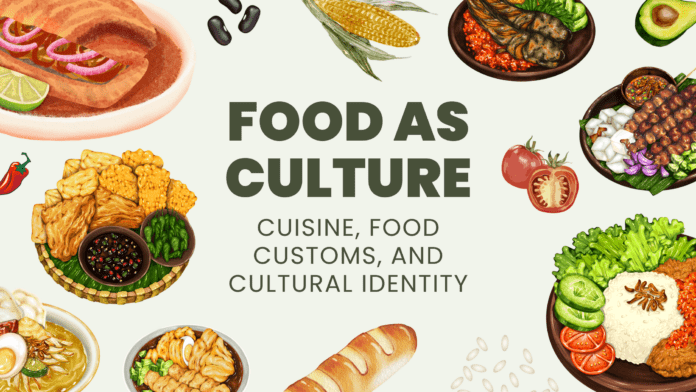Table of Contents
Food is the universal language of love, comfort, and celebration. It binds communities, recounts history, and mirrors the culture it originates from. Our quest for new flavours and experiences has transformed how we perceive food. It’s no longer just satiating the taste buds; it’s about understanding the story behind every spice, relishing the tradition behind every dish, and experiencing the friendliness that meals bring to a culture.
In this sprawling food exploration, we’re travelling beyond the plate, uncovering the narratives that define our global gastronomic heritage. This isn’t just a food tour; it’s an odyssey of tastes, sights, and sounds that paints a holistic picture of culinary excellence from around the globe. Whether you’re a seasoned foodie or an aspiring culinarian, Fasten your seatbelts as we take you on a flavour-fueled trip around the world, starting from your kitchen and stretching across continents.
The Global Pantry
The world’s culinary landscape is a testament to a prosperous trade, travel, and cultural exchange history. Exotic spices, rare ingredients, and age-old cooking techniques have crossed borders, catalyzing a fusion of flavours that uplift dishes to a level of artistic expression.
Walk into any kitchen—from the bustling street food stalls of Asia to the family-owned trattorias of Italy—and you’ll find a personal twist on some of the oldest and most beloved recipes. From the fragrant curries of the East, enriched by centuries of colonizing influences, to the hearty stews simmering in the potjie pots of Africa, which celebrate locally sourced game and produce, the art of combining indigenous ingredients with unexpected elements remains at the core of diverse in cuisine worldwide.
Historically, the spice trade introduced the likes of cinnamon, pepper, and nutmeg to the world, creating a demand for the exotic and the unknown. Even today, globalization and migration continue to merge these distinct culinary traditions. The result? A genuinely global pantry, where soy sauce in Italian pasta or Korean kimchi in Mexican tacos is both a surprise and a delight.
The Journey
Every ingredient has a story. Behind the succulent ribeye is the rancher who raised the cow, the butcher who carved the meat, and the chef whose expertise transformed it into a masterpiece. Understanding this narrative is to uncover the essence of a community’s livelihood and values.
The food we relish often tells tales of sustainable farming practices, organic agriculture, and artisanal techniques that have stood the test of time. In the lush paddy fields of Bali, cultivating rice is more than just a means to an end; it’s a sacred ritual that honours the earth and its bounty. In the olive groves of Tuscany, the pressing of olives is a centuries-old tradition celebrated each year with enthusiasm and festivity.
Akin to a treasure hunt, tracing back the origin of our meals takes us on a sweeter path, quite literally. Whether sipping on freshly brewed coffee in the hills of Colombia or indulging in a slice of apple pie just outside the orchards of Vermont, there is a profound connection between the land, the food, and the culture that fosters a deep appreciation for every bite.
Hidden Gems
Amidst the tourist-laden avenues and acclaimed dining hotspots lie the hidden gems of global cuisine. These could be the unassuming corner cafes where the locals line up for their morning bánh mì in Hanoi or the family creperie tucked away in a cobblestone alley in Brittany.
These lesser-known culinary meccas are pure in their offerings, untainted by the demand for the ‘next Instagrammable dish.’ They serve as incubators for authentic culinary experiences, offering a window into a community’s traditions and daily delights. Here, the menu tells a story, often passed down for generations, revealing the soul of a culture through its sustenance.
Venture into these spots, and you might find a local treat that stays with you long after you return home, like the deceptively simple clam chowder from a Maine seaside shack or the fiery vindaloo made of a secret recipe guarded by Goan grandmothers. Such discoveries are about the food and every bite’s history.
Fusion and Innovation
Culinary innovation is as fluid as the markets where new ingredients are introduced daily. The past few decades have seen the rise of fusion cuisines—gourmet experiments that cross traditional lines to create dishes that challenge our palates and spark our imaginations.
Sushi burritos, Indian tacos, and the Cronut are paragons of this creativity that defies the conventional. But fusion isn’t merely about combining elements from various cuisines; it’s about merging the roots of these culinary traditions to create flavours that are a homage to the original yet refreshingly novel.
On the flip side, innovation means rediscovering ancient practices and forgotten flavours. In the current wave of health-conscious dining, there’s a resurged interest in pre-colonial Latin American cuisine, which celebrates dietary staples like quinoa, amaranth, and chia seeds, bringing them back into the spotlight as nutritional powerhouses.
The Experience
Food is a sensory experience that goes beyond taste. It’s about how a dish is presented, the sounds of a busy kitchen, the feel of a warm, crusty loaf of bread, and the aromas that evoke memories long buried. A dining table is a place of convergence, where we partake in communion with those we love and with strangers who become friends over the shared act of eating.
The rituals around food, such as the Italian passeggiata or an Arabian coffee ceremony, offer insights into the social fabric of a community. Each bite carries the weight of cultural etiquette and tells a story of hospitality, respect, and communal living. These narratives are not apparent in cookbooks or online recipes; they are experienced, and once experienced, they are remembered.
Conclusion
In our relentless pursuit of the following best eat, we often overlook the cultural richness that is inherently embedded in our daily meals. We forge connections that transcend geographical boundaries by breaking bread across the globe. We learn that food is not just about hunger; it’s about history; it’s not merely sustenance; it’s a shared human experience.
The next time you sit down for a meal, take a moment to savour not just the taste of the food but the richness of its story—how it came to be, the hands that crafted it, and the culture that gave it life. After all, to truly appreciate a culture, one mustn’t just visit; one must dine.
With this new lens through which to view the world, we encourage you to set out on your own culinary explorer’s path. Seek out those forgotten recipes, hidden eateries, and age-old rituals. Immerse yourself in the art of food and the culture it signifies. In doing so, you’ll find that the secrets to a happy and fulfilled life often lie on the plates we pass around the table.





